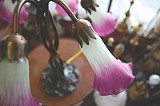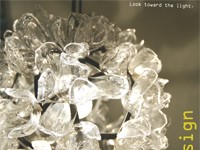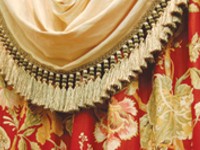[
{
"name": "500x250 Ad",
"insertPoint": "5",
"component": "15667920",
"parentWrapperClass": "",
"requiredCountToDisplay": "1"
}
]
Think "chandelier" and you're likely to conjure images of those mammoth crystal monstrosities that dominate concert halls, ballrooms, or, at the very least, your grandmother's dining room.
But chandeliers don't have to be stuffy or fussy affairs. Modern styles come in all sizes, colors, and shapes, and at affordable prices, too. In fact, you can now find these dazzling fixtures in all types of homes now, from bungalows to Victorian to Mission style.
Historically chandeliers appeared mostly in formal settings, such as dining areas, foyers, and hallways. But recently, they've infiltrated bedrooms, bathrooms, pantries, or any other empty space needing a touch of drama and flair.
"What's great about a chandelier is that it has all kinds of interpretations," says Elizabeth Lyons, director of More Fire Glass Studio, which features a new exhibit showcasing chandeliers made by local artists. "Chandeliers can be austere and simple, or drippy, or very elaborate and over the top."
Ready-made chandeliers are readily available at your local home improvement center, but for the finds with real character and personality, you should scout antique shops and artist galleries for deals. In fact, many Rochester artists concentrate in lighting fixtures and glass. "Rather than get something that's a rip-off or something that's mass-produced, you could have a real labor of love," says Lyons. "Having those kinds of things in your home really makes a difference."
However, chandeliers can get expensive. Small antiques start in the hundreds of dollars, and even the mass-produced, pre-fabricated ones at home improvement stores rarely sell for less than $150. Just as with any investment, you'll need to do your homework first before you buy.
Foremost, you'll need to know what size chandelier you want. That depends primarily on the size of the room in which it will be installed. "You need the right proportion," says Brian Hansen, owner of Lamp Repair on North Winton Road, which specializes in restoring and reselling antique lighting fixtures. "If you have a 10'x10' dining room, you're not going to want a chandelier that's 4' in diameter." Chandelier size also hinges on the existing furniture in the room. A long, slender chandelier will make a room with tall hutches or cabinets seem cramped. Likewise, a wide or short chandelier above a low table will make the room appear sparse, even severe.
The rules of thumb regarding proportion vary, but Hansen suggests keeping a chandelier at least 30" to 36" above any table or furniture setting. Keep in mind that ornate fixtures will seem bigger than they actually are, whereas simpler pieces will seem smaller. Therefore, it helps to keep measurements of the room in question at hand when you go shopping.
Also bear in mind that chandeliers can be heavy beasts, so you'll probably need to replace your ceiling's existing electrical box (usually rated for max loads of 50 lbs) with one that can support the extra weight. The easiest approach is to install an expandable fan brace. Designed for ceiling fans, fan braces can also be used to support chandeliers up to 150 lbs. Just fit the brace in the existing ceiling hole and, using a wrench, expand it until its prongs dig into the joists. Then you can bolt a new electrical box to the brace and hang the chandelier from the box.
When shopping for chandeliers, you'll also need to consider illumination. The amount of light produced and the shadows cast by the chandelier should be weighed against the lighting needs of the room. Modern pieces can be blindingly brilliant, just barely bright enough to light themselves, or anywhere in between. "I suggest to all my customers that they put chandeliers on a wall-switch dimmer," says Hansen. "That way, they can have it bright if they want to see, or they can turn it down if they want it to be pretty."
But light bulbs can make all the difference. "You can shift things quite a bit just by changing the kind of light bulb you put in," says Lyons. (Be sure not to exceed the recommended wattage for your wiring, though.) If changing the light bulb isn't an option, then you can always places shades over your bulbs, which not only prevents glare, but also adds personality to the chandelier and colored mood lighting to the room.
The most difficult issue in choosing a chandelier is narrowing down the piece's artistic style. It helps to ask shop owners for catalogues, or to snoop around showroom floors to get ideas. Ultimately, though, the choice depends on the rest of your décor. Traditionally decorated rooms will demand an elaborate chandelier, while modern looks will want a simpler fixture. While the latest trend is to mix and match styles --- for instance, a crystal chandelier above a carved farmhouse kitchen table --- don't get too carried away. Classic looks never go out of style, and the funkier the design, the harder it will be to fit with any future furniture you might purchase.
Indeed, many designers suggest that you match your chandelier choice not to your current décor, but to the architecture of your house, particularly the time period in which it was constructed. "If you live in an old house, something new just doesn't look good," says Hansen. Newer houses are more flexible. "Something old or new could fit," he explains. "Besides, if you need a big chandelier, you almost have to get a new one."
Also consider the amount of time and effort you're willing to commit to your chandelier's care, as they attract dust and grime. Older chandeliers or ones made by individual artists can usually be taken apart for cleaning and repair. But since the manufacture of many newer models has been outsourced overseas, their maintenance will be more difficult.
The right chandelier is a complicated, crucial design choice. But Hansen argues that it pays off. "Lighting makes the room," he says. "It sets everything off. If everything's right except the lighting, then it really isn't all right. But if everything's right including the lighting? Then everything is right, after all."
In This Guide...
Latest in Home Design
More by Lara Crigger
-
Encyclopedia "Galactica"
Jan 17, 2007 -

The King goes digital
Jan 10, 2007 -
Netflix for gamers
Dec 20, 2006 - More »






